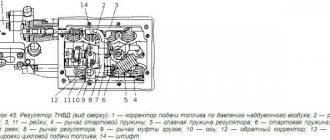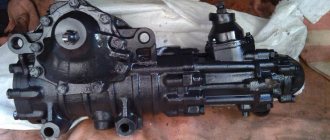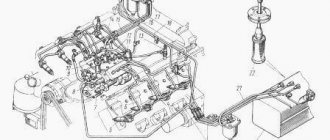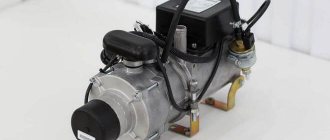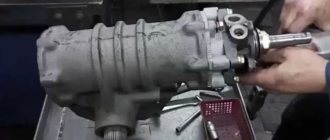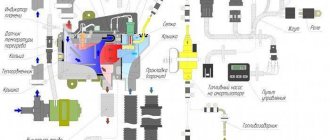Natural gas methane, as an alternative motor fuel, tempts with its reserves in Russia. In addition, it is characterized by high detonation resistance and low toxicity. Soft operation of the engine increases its service life before major overhaul by one and a half, two times, and reduces oil consumption by half.
Gazprom will expand the country's domestic market thanks to gas motor fuel. Agreements have already been signed with a large domestic company, the KAMAZ automobile corporation.
Among the world's popular companies that produce heavy trucks, this corporation occupies 16th place. It includes more than 150 organizations that are located in Russia and other CIS countries. The production of trucks covers the entire technological cycle of the group of organizations.
It all starts with design, modeling, automotive assembly and installation of automotive components, and ends with the implementation of manufactured vehicles and service.
In addition, based on the policy of increasing the need for the use of compiled natural gas as the main fuel for engines, the company is the main company in the supply of specialized vehicles. Today it is impossible to imagine the market for gas engine products without KAMAZ OJSC.
In addition to supplying vehicles to Gazprom's subsidiaries (626 units), KAMAZ sold more than 200 types of new vehicles. The gas-cylinder version is now installed in municipal buses and modified municipal equipment.
The company's gas cylinder transport will be produced in Naberezhnye Chelny. More than 500 automobile models will be created there every year. Here you can read about all Kamaz models.
KamAZ on gas: reviews from owners of trucks with a gas engine
Natural gas methane, as an alternative motor fuel, tempts with its reserves in Russia.
In addition, it is characterized by high detonation resistance and low toxicity. Soft operation of the engine increases its service life before major overhaul by one and a half, two times, and reduces oil consumption by half. Gazprom will expand the country's domestic market thanks to gas motor fuel. Agreements have already been signed with a large domestic company, the KAMAZ automobile corporation.
Among the world's popular companies that produce heavy trucks, this corporation occupies 16th place. It includes more than 150 organizations that are located in Russia and other CIS countries. The production of trucks covers the entire technological cycle of the group of organizations.
It all starts with design, modeling, automotive assembly and installation of automotive components, and ends with the implementation of manufactured vehicles and service.
In addition, based on the policy of increasing the need for the use of compiled natural gas as the main fuel for engines, the company is the main company in the supply of specialized vehicles. Today it is impossible to imagine the market for gas engine products without KAMAZ OJSC.
In addition to supplying vehicles to Gazprom's subsidiaries (626 units), KAMAZ sold more than 200 types of new vehicles. The gas-cylinder version is now installed in municipal buses and modified municipal equipment.
Specifics, pros and cons
Methane-powered cars are not a new thing for a long time. Recently, at KAMAZ and in the whole country, this topic has been discussed especially actively. As part of this project, the automotive giant held a scientific conference for consumers of natural gas vehicles.
It was there that automotive geniuses shared their experience of use, and buyers evaluated and chose the most suitable offers.
Each car that runs on methane saves 2-4 million rubles a year, and therefore, despite the higher acquisition cost, gas-cylinder cars pay for themselves much faster than diesel ones.
Manufactured vehicles running on compiled natural gas comply with all environmental standards, and their noise and smoke levels are significantly reduced. The next goal is the transition to liquefied methane. The company already produces dump trucks that already run on liquefied gas.
Production of the gas engine began three years ago. The production of equipment with a gas engine will not only renew the aging fleet of municipal vehicles, but will also significantly improve the environmental situation. After all, gas exhaust is cleaner and meets international standards according to its standards.
In addition, a gas engine is cheaper to operate. The actual production of gas engines is not inferior in quality to competing companies, and it is also cheaper, which makes it even more in demand. Another advantage is that interested individuals will receive subsidies from the budget when purchasing equipment using gas engine fuel. Read about model 65115, which runs on gas.
Consumers very often ask what distinguishes seemingly identical propane and butane? The first component is much heavier than air.
It goes down, in case of a leak, if the vehicle is in the repair area, the lower part of the room will be filled with gas. There may be a risk of explosion.
Another gas, methane, rises to the top because it is lighter than air. Methane is a natural element. According to researchers, its reserves will never run out. The development of gas engine technology began precisely for this reason, and the technology of the future will run exclusively on methane.
The main advantages of such transport
- Saves money on fuel several times;
- The engine's operation is almost inaudible;
- Exhaust gases and toxic substances will no longer pollute the external environment;
- The money that would have to be paid for emissions into the environment is saved 4 times;
- Significant savings on additional purchases, expensive catalytic systems and urea will no longer be needed;
- Methane will be used as a combustible material. It positions itself as the safest fuel for motors compared to other, less environmentally friendly analogues.
Many buyers doubt that a gas installation is safe for their car. This is the main negative characteristic of such equipment, according to customers. How safe is it to drive with a gas cylinder instead of diesel fuel?
It's completely harmless. Cylinders undergo rigorous strength tests before installation. The working pressure of each cylinder is taken into account and this coefficient increases three times. In addition, the cylinders are subjected to pistol fire, attempts are made to burn them, and they are thrown from high-rise buildings.
The company is not aware of any cases where there was something wrong with the cylinder. The internal metal casing and plastic braids protect it from any type of impact.
The valves are located on the top of the cylinder, they are configured to automatically open and close when the car is moving.
Another disadvantage is that the gas installation will not work properly even in the winter. Each KAMAZ model has a built-in preheater, which also runs on methane. In addition, it is necessary to take into account a central lubrication system, which can be controlled autonomously or mechanically.
Main characteristics of gas-cylinder KAMAZ
The motor is here, represented by model 820.60. Vehicle parameters: 7300X2500X2845 mm. The model is equipped with an interaxle differential lock and inter-wheel lock, and has spring lighting installed.
Consumption of this KAMAZ model on methane: 34 l./100 km. (same as 65205) Model price 2,857,220 rub.
All information about Kamaz can be found on our website. This is an overview of the dimensions of Kamaz equipment.
You will learn about the capacity of Kamaz in this article..
It will also be interesting to see the price range for Kamaz.
City Bus 5299-30 on methane gas - characteristics and fuel consumption
Transportation of citizens and guests of the country along narrow city roads is now possible using gas-cylinder semi-low-floor transport.
All-metal body, double doors with pneumatic drive. Rear engine. Ventilation is classic, through opening hatches and molds. 984 l. constitutes the total volume of the fuel system cylinders, it can accommodate 197 m3 of CNG at a force of 200 atm. The semi-low-floor design increases the convenience of getting into and out of the vehicle.
The power unit uses a VOITH D845.3E gearbox. The KAMAZ gas engine is represented by model 820.61. Characteristics of the 5299-30 KAMAZ methane model. Overall dimensions: 11875Х 2050Х 3400 mm. Model price 7,660,000 rub.
For transporting citizens and guests of the country along routes that lead outside the city, class 2 transport 5299-0000011-31, model 5299-011, is suitable. It has seating available, as well as areas that are most suitable for passengers who want to stand.
The bus consists of an all-metal frame, one-piece body. The advantage is its resistance to maintaining the desired air temperature and the rear location of the engine. Ventilation is natural, through open windows and hatches.
Heating system: built-in autonomous and emergency. The first one works from a gas heater, the other one works in addition to the main one. These are the main features of this Kamaz model on methane. Model price 8,708,300 rub.
Consequences of installing gas for a car
Methane-powered cars have a number of operational consequences. In particular, we are talking about characteristic engine breakdowns, general wear and tear, loss of power, etc.
Car owners often note that the use of this equipment, which allows the car to run on methane, causes the block head to warp, since it simply heats up more on gas and has to be polished over time. This failure, noticed at the wrong time, threatens to overhaul the engine.
The easiest way to notice a malfunction is due to some instability in the idle operation of the car after a short run.
Another important aspect is valve burnout, which can cost the owner a pretty penny.
Operating consequences due to processes occurring inside the system affect valves, cylinders and pistons! This quite often results in an expensive and very technologically complex pleasure. As for the general wear and tear of the car, it is difficult to comment on this factor.
We can only say with certainty that over time, under the influence of many factors, there is a loss of vehicle power, which cannot but affect the overall technical condition of the vehicle.
To develop the gas motor fuel market, it is necessary to act comprehensively. Some must create high-quality equipment, others must provide it with services, and others must provide the country with gas filling infrastructure.
Soon, government programs will take part in creating a decent service for this type of transport.
This year it is planned to install block refueling modules at ready-made refueling stations.
To summarize, we can note that methane-powered technology is environmentally friendly and accessible. Many modern cars equipped with these installations make using the car more economical and functional. Gas emissions become very clean and harmless, and this is a huge plus for the environment and more.
It is expected that in the near future, equipment will run exclusively on methane.
In the meantime, read the article about new Kamaz models.
Check out the savings!
After the payback period ends, HBO will begin to save your money. Over the course of a year of operating a converted car, you will save:
- for Hyundai Sonata – 86,400 rubles;
- for PAZ-32050R – 672,210 rubles;
- for KAMAZ-4308-N3 – 19,360 rubles;
- for Gazelle – 178,500 rubles.
- for Hyundai Solaris – 148,750 rubles.
LPG installed by professionals will significantly reduce the cost of operating your car!
“Order installation calculation”
Methane-powered tractor: a trucker's dream or a headache? 16:36, January 13, 2020 Print version
All holders of category “C” rights consider themselves professionals. Those who have been driving trucks for several years are often overconfident. In fact, even experienced drivers often make mistakes. Especially when it comes to commercial vehicles running on methane.
The most advanced truck drivers were the first to pay attention to the methane Iveco Stralis NP460. Its gas engine is Cursor 13 with a displacement of 12.9 liters and a potential of 460 hp. With. Well prepared for harsh operating conditions. Italian gas cylinder equipment (GBO) can withstand high humidity, polluted air and is not afraid of cold weather. The plant guarantees easy start-up and operation even at ambient temperatures down to –40 ºС. This is typical for both vehicles consuming compressed methane (CNG) and vehicles running on liquefied natural gas (LNG) or a combined CNG+LNG combination.
For successful operation of a car with a gas engine in winter, it is important to prepare the gas equipment for cold weather.
On the flagship Stralis NP460 LNG, the capacity of two 220 kg cryogenic cylinders is enough for a range of 1600 km. In the CNG+LNG version (540 liters of liquefied gas + 4x115 liters of compressed methane) the autonomy is 1100 km. When equipped with only compressed methane, the reserve is about 570 km. Now do you understand why carriers prefer LNG?!
It is contraindicated for a gas truck to stand idle for a long time. At a pressure of liquefied methane of 10 bar, its maximum storage time is five days, and at a pressure of 14 bar - a day. After this, gas leaks into the atmosphere through the safety valve...
Calculation formulas
To determine the payback and benefits of HBO, it is necessary to find out how much money per day will be needed to operate a car with and without equipment. Calculation formulas will depend on the type of source fuel, because methane replaces 40% of diesel fuel, and gasoline - 100%.
Calculation for cars running on diesel fuel
Let's start with KAMAZ-4308-N3:
- 25l*40%=10 l or 12 m3 will be methane consumption per 100 km
- 25 l*60%=15 l will be diesel fuel consumption per 100 km
- 12 m 3 *12.5 rub. (cost of methane) = 150 rub.
- 15 l*35 rub. (cost of diesel fuel) = 525 rub.
- 150 rub.+525 rub. =675 rub. per 100 km of gas diesel operation
- 675 rub. * 4.4 (daily mileage) = 2970 rub. /day you will spend on gas diesel
Without HBO, daily expenses will be 25 l * 35 rubles * 4.4 = 3850 rubles.
Calculation for gasoline cars
| Car name | Methane consumption per 100 km | Methane costs per day | Gasoline costs per day |
| Hyundai Sonata | 8 m3 | 8 m3*12.5 rub.*4= 400 rub. | 8 l*35 rub.*4= 1120 rub. |
| PAZ-32050R | 25 m3 | 25 m3*12.5 rub.*5.69= 1778 rub. | 25 l*35 rub.*5.69= 4979 rub. |
| The calculations are slightly different, since propane consumption increases by 15%. | |||
| Gazelle | 20 l+15%=23 l | 23 l*17.5 rub.*3= 1207.5 rub. | 20 l*35 rub.*3= 2100 rub. |
| Hyundai Solaris | 10 l+15%=11.5 l | 11.5 l*17.5 rub.*5= 1006.25 rub. | 10 l*35 rub.*5= 1750 rub. |
Methane-powered trucks: how much does it save? (spoiler - very!)
A year after the launch of a new line of Scania equipment on our market, methane modifications of the P, G and R series appeared with an endless number of variations of cabs, wheel configurations and load capacity.
Fuel costs eat up the lion's share of carriers' budgets. Even with very competent logistics and a fresh fleet, the cost of fuel is no less than a third of income, and sometimes even reaches half! There are two exits. First: reduce fuel consumption - but here the limit has almost been reached. Second: use cheap fuel. What could be more affordable than natural gas?
There are two gas engines to choose from for the new line of Scania trucks - a five-cylinder (9.0 l, 340 hp) for the junior cabs of the P and G series and a 13-liter inline six for the G and R series (up to 410 hp .). The engines are almost as good in torque as diesel engines of similar power, and this is extremely important for trucks.
Methane engines, like conventional gasoline engines, operate according to the Otto cycle with all that it implies - spark ignition and a low compression ratio. Toxicity standards are Euro 6. And no urea is needed. All CNG trucks are equipped with the Opticruise robotic transmission.
The engine is lighter than a diesel engine, but the total weight of the vehicle has increased by half a ton - you need a lot of cylinders for a solid power reserve.
It would be possible to install lightweight composite ones instead of steel ones, but there are other difficulties. Verification of such cylinders is mandatory every six months, and their service life is 10 years. Steel ones have a twice as long life cycle, and verification is carried out every five years.
Tight budget
Was it worth building a gas garden? Savings per kilometer due to cheap fuel range from 6 to 9 rubles. With an annual mileage of 200,000 km, a gas Scania will help save one and a half million rubles. What if there are ten cars in the park?
Another trump card: the estimated life of the gas engine before overhaul is 2,000,000 km. Because there are no shock “diesel” loads, no sulfur in the fuel and, as a result, deposits and soot.
What's the catch? In power reserve. Gas with a total volume of cylinders of 190 m³ is enough for an average of 500 km. Not much for a long-haul tractor. But the situation with methane gas stations in our great gas power is still very difficult.
Nevertheless, the fleet of methane Scanias is growing: companies are doing this for the sake of multimillion-dollar savings on fuel. They even build gas stations on their own territories: if there are ten or more cars in the fleet, this is a profitable idea - it can pay for itself in the third year. And then, you see, the number of methane gas stations in the country will increase.
Your benefit
| Car name | Expenses per day with HBO | Expenses per day without HBO | Your benefit per day | Payback period for gas equipment when operating 20 days per month |
| Hyundai Sonata | 400 rub. | 1120 rub. | 720 rub. | 6 months |
| PAZ-32050R | RUB 1,778 | 4979 rub. | 3201 rub. | 1.5 months |
| KAMAZ-4308-N3 | 2970 rub. | 3850 rub. | 880 rub. | 10.8 months |
| Gazelle | 1207.5 rub. | 2100 rub. | 892.5 rub. | 2 months |
| Hyundai Solaris | 1006.25 rub. | 1750 rub. | RUB 743.75 | 2.3 months |
The principle of operation of KamAZ truck engines on methane
Natural gas used as a motor fuel is highly resistant to detonation and reduces harmful emissions. Motors with spark and compression ignition can operate on gaseous fuel. The methane-powered KamAZ truck began to be developed in 1984, and several small series were produced. With the collapse of the USSR, the assembly of such equipment ceased. In 2015, new versions of trucks equipped with gas-diesel engines appeared in the plant’s production program.
How does it work?
Due to the increased octane number of gas fuel, the use of a standard engine is unacceptable. To operate on pure methane, a new engine is required, which increases the cost of the car. Therefore, the gas KamAZ is equipped with a specially modified standard power plant. The engines have a cylinder head with a different design, which reduces the compression ratio to 12. The piston group and valves are subject to changes, since the combustion temperature of the gas mixture is higher.
The operating principle of the engine is based on the ignition of a mixture of gas and air by a spark from a spark plug, which is installed instead of a fuel injection nozzle. Gas is supplied by a multi-point injection system into the intake manifold. The injectors are located next to the cylinder inlet ports, which ensures homogeneity of the mixture and reduces exhaust toxicity. Fuel supply and ignition are controlled by an electronic controller.
An alternative option is based on mixing liquid diesel fuel with gas in the required proportion.
Starting the power plant is possible only on diesel fuel. The gas is then supplied through a special reducer, which reduces the pressure. After this, the gas entered the mixer, which formed the working mixture. The design of the unit had a rotation speed regulator, and also installed a limiter on the volume of the supplied combustible mixture.
The working mixture was compressed in the cylinder. A small dose of diesel fuel is used for ignition. The moment of dose delivery is calculated in such a way that it ignites before the gas volume. After the diesel fuel flashes, a mixture of methane and air begins to burn. This gas engine design made it possible to operate on liquid and gaseous fuel. But the design did not receive development.
Early and experimental versions of the vehicles were equipped with a cylinder installation located behind the cab or on the frame. Then a diagram appeared for mounting 8 cylinders parallel to the frame side members. The tanks are installed symmetrically to the longitudinal axis of the vehicle on special protective supports. There is a combined scheme: some of the tanks are mounted behind the cab, and some are mounted under the loading platform or dump body. All cylinders are connected to each other by lines with safety valves and valves.
How people in Chelny drive “on sour cream”: we visited the production of gas trucks
When gas buses with the inscription “I drive on methane” appeared in Naberezhnye Chelny, the townspeople began to joke: “I drive on sour cream.” So I decided to see how the local company RariTEK, a partner of KAMAZ, converts ordinary trucks and buses into “sour cream-powered” ones.
Gasification of transport is developing slowly but steadily. To date, almost 60,000 trucks and 10,000 buses in Russia have been converted to methane fuel. RariTEK specialists have created a whole range of gas machines. According to the developers, methane engines meet Euro-6 standards, methane is much cheaper than diesel fuel and it cannot be drained from the tank “to the side.”
Alas, there are no miracles - there are also disadvantages. With an octane rating of 120, only specially designed engines can run on pure methane. To use it in conventional units, it has to be mixed with diesel fuel (up to 50%), but even then the valves and the block head suffer from the load. Another problem: installing cylinders eats up the carrying capacity. Finally, the cost of remodeling starts from 200 thousand rubles.
Specifications
Main characteristics of the engine of the KamAZ-840 family:
- cylinder diameter - 120 mm;
- piston stroke - 130 mm;
- working volume - 11760 cm³;
- power - 300 hp at 1900 rpm;
- torque - 1225 N/m at 1200-1400 rpm;
- compression ratio - 12;
- fuel consumption - 25-30 m³ of gas per 100 km;
- toxicity standard - Euro-4.
Some modifications of KamAZ trucks are equipped with imported diesel engines adapted to run on methane. The motors meet Euro-5 standards. The plant produces trial models of cars with a Mercedes Benz engine capable of running on both pure diesel fuel and a mixture of diesel fuel and methane.
The gas supply is located in cylinders located behind the cabin (80 l capacity) and on the frame (100 l capacity). The standard equipment includes the installation of 9 small and 7 large containers with a capacity of 1420 liters. The total reserve of methane, compressed to a pressure of 200 atm, is 284 m³.
Initial data
| Car name | Cost of installation of HBO | Equipment | Vehicle mileage per day | Fuel consumption |
| Hyundai Sonata | 82,000 rub. | HBO and 1 methane cylinder of 50 l (12.5 m3) | 400 km | 8 liters of gasoline per 100 km |
| PAZ-32050R | RUB 97,000 | HBO and 5 methane cylinders of 50 l (12.5 m3) | 569 km | 25 liters of gasoline per 100 km |
| KAMAZ-4308-N3 | 190,000 rub. | HBO and 5 methane cylinders of 50 l (12.5 m3) | 440 km | 25 liters of diesel fuel per 100 km |
| Gazelle | 36,000 rub. | LPG on propane | 300 km | 20 liters of gasoline per 100 km |
| Hyundai Solaris | 34,000 rub. | LPG on propane | 500 km | 10 liters of gasoline per 100 km |

